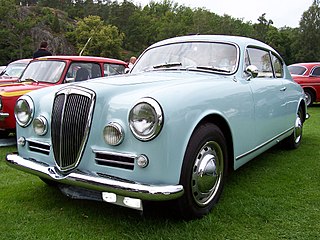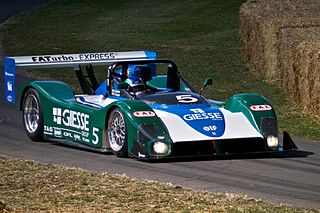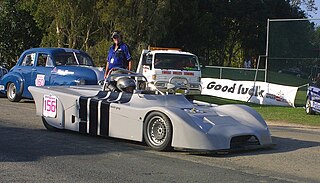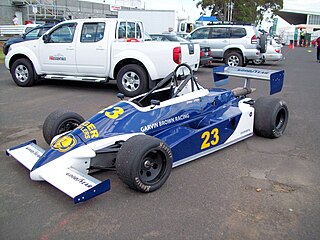
A sports car is a car designed with an emphasis on dynamic performance, such as handling, acceleration, top speed, the thrill of driving and racing capability. Sports cars originated in Europe in the early 1900s and are currently produced by many manufacturers around the world.

Sir Stirling Craufurd Moss was a British Formula One racing driver. An inductee into the International Motorsports Hall of Fame, he won 212 of the 529 races he entered across several categories of competition and has been described as "the greatest driver never to win the World Championship". In a seven-year span between 1955 and 1961 Moss finished as championship runner-up four times and in third place another three times.
Governments and private organizations have developed car classification schemes that are used for various purposes including regulation, description, and categorization of cars.
The National Basketball Association Most Valuable Player Award (MVP) is an annual National Basketball Association (NBA) award given since the 1955–56 season to the best performing player of the regular season. The winner receives the Maurice Podoloff Trophy, which is named in honor of the first commissioner of the NBA, who served from 1946 until 1963. Until the 1979–80 season, the MVP was selected by a vote of NBA players. Since the 1980–81 season, the award is decided by a panel of sportswriters and broadcasters throughout the United States and Canada.

A grand tourer (GT) is a type of car that is designed for high speed and long-distance driving, due to a combination of performance and luxury attributes. The most common format is a front-engine, rear-wheel-drive two-door coupé with either a two-seat or a 2+2 arrangement. Grand tourers are most often the coupé derivative of luxury saloons or sedans.

The Toyota Starlet is a subcompact car manufactured by Toyota from 1973 until 1999, replacing the Publica, but retaining the Publica's "P" code and generation numbering. The first generation Starlet was sold as the Publica Starlet in some markets. In Japan, it was exclusive to Toyota Corolla Store dealers.

The Datsun Sports, was a series of roadsters produced by Nissan in the 1960s. The series was a predecessor to the Z-car in the Fairlady line, and offered a competitor to the European MG, Triumph, Fiat and Alfa Romeo sports cars. Beginning with the 1959 S211, the line was built in two generations: the first generation was largely handbuilt in small numbers, while the second generation was series produced. The second generation first appeared in 1961 and continued through 1970 with the SP311 and SR311 lines.

Sebring International Raceway is a road course auto racing facility in the southeastern United States, located near Sebring, Florida.

Homestead–Miami Speedway is a motor racing track located in Homestead, Florida. The track, which has several configurations, has promoted several series of racing, including NASCAR, the IndyCar Series, the WeatherTech SportsCar Championship series, and the Championship Cup Series.

A Le Mans Prototype (LMP) is the type of sports prototype race car used in the 24 Hours of Le Mans, FIA World Endurance Championship, IMSA SportsCar Championship, European Le Mans Series and Asian Le Mans Series. Le Mans Prototypes were created by the Automobile Club de l'Ouest (ACO). The technical requirements for an LMP include bodywork covering all mechanical elements of the car. Currently, there are three classes within Le Mans Prototypes, designated LMP1, LMP2, and LMP3.

The Ferrari 333 SP is a sports prototype race car that was built by Italian race car manufacturer Dallara and later Michelotto to compete in the World Sports Car championship for Ferrari. Unveiled at the end of 1993, at the behest of amateur racer Giampiero Moretti, the 333 SP marked Ferrari's official return to sports car racing after a 20-year absence. The car was built to compete in the IMSA's new WSC class, which replaced the previous GTP cars.

The Nissan S20 engine 2.0 L (1,989 cc) was a straight-6, DOHC internal combustion engine produced by Nissan from 1969 to 1973, originally designed by engineers of the former Prince. It was essentially a revised production variant of the 1966 Prince GR8 engine from Prince/Nissan's R380 racecar. It produces 160 hp at 7000 rpm and 177 N⋅m; 130 lbf⋅ft (18 kg⋅m) of torque at 5600 rpm. The S20 weighs 199 kg (439 lb). This engine is not to be confused with the unrelated Nissan SR20, which is a straight 4 cylinder petrol engine used in other Nissan models.

Sport compact is an American car classification for a high-performance version of an affordable compact car or a subcompact car. There is no precise definition and the description is applied for marketing purposes to a wide variety of models.

The Alfa Romeo Alfetta is a front-engine, five-passenger sedan and fastback coupé manufactured and marketed by Alfa Romeo from 1972 to 1987 with a production total over 400,000.

Sports 2000 is a restricted-rules class of two-seat, mid-engined, open-cockpit, full-bodied sports-prototype racecar used largely in amateur road racing. Sometimes known as S2000 or S2, the class was developed by John Webb, then of the Brands Hatch racing circuit in England, as an affordable form of sports car racing, essentially a sports car version of Formula Ford 2000. The key attributes of the class were a body design reminiscent of two-liter Group 6 sports racing cars like the Chevron B21 and Lola T-212 but with an ultra-reliable and inexpensive drivetrain comprising a two-liter "Pinto" overhead camshaft engine with very limited allowed modifications and the well-proven, VW-based Hewland Mk 9 transaxle. S2000 aerodynamics continued to evolve beyond their 1970s Group 6 roots, with very 'slippery' cars featuring spats over the wheels becoming the norm.

Tiga Race Cars Ltd. was a British auto racing constructor and team. The company was founded in 1974 by two former Formula 1 drivers, Australian Tim Schenken and New Zealander Howden Ganley. The company's name was formed by the first two letters of Tim and Ganley. Tiga constructed racing cars for various forms of open wheel racing and sports car racing, ranging from Formula Ford to the World Sportscar Championship.

Formula SCCA or Formula Enterprises is a class of open wheel race car sanctioned by the Sports Car Club of America. A spec racing class, all chassis are produced by SCCA Enterprises in association with Van Diemen and include a sealed Mazda MZR powerplant. The chassis can also be fitted with closed-wheel bodywork and converted into a sportscar to race in C Sports Racer or the L3 class of IMSA Prototype Lites. For the 2012 season, the car was also accepted into the U.S. F2000 National Championship's National Class. According to the manufacturer's website, as of March 2010, 120 of the cars have been sold.
The 1981 Australian Sports Car Championship was a CAMS sanctioned Australian motor racing title open to Group D Production Sports Cars. It was the thirteenth Australian Sports Car Championship and the last to be restricted to cars complying with Group D regulations. The championship was won by John Latham, driving a Porsche Turbo.
The Dome RC82 was a Group C sports racing car built by Dome in 1982 for the 24 Hours of Le Mans. Initially fitted with a 3.3-litre Cosworth DFL V8 engine, the car finished its life fitted with an 8-litre Chevrolet V8 engine. March Engineering built the chassis, and one car was built. The car would prove to be unsuccessful, as it never finished a race, and was replaced by the marginally more successful Dome RC83 the following year.
The March 82G is a IMSA GTP/Group C sports prototype race car, designed, developed and built by British manufacturer and constructor March Engineering, for sports car racing, in 1982. It competed in motor racing between 1982 and 1986, but only scored 1 race win, 8 podium finishes, and 2 pole positions. It was powered by a naturally-aspirated 620 hp (460 kW) 5.7 L (350 cu in) Chevrolet V8 engine.















